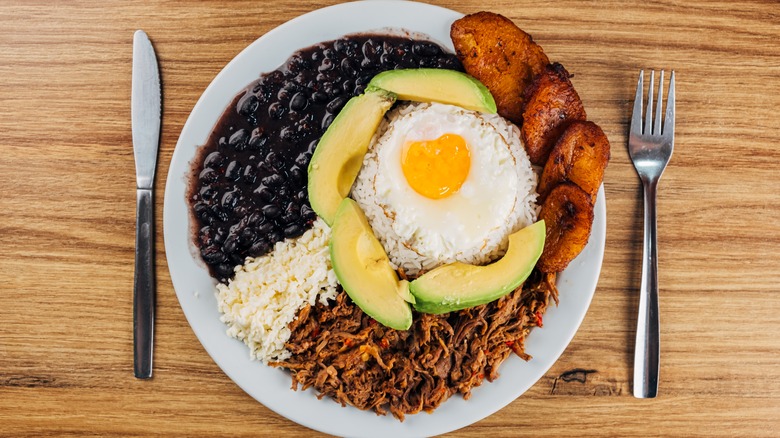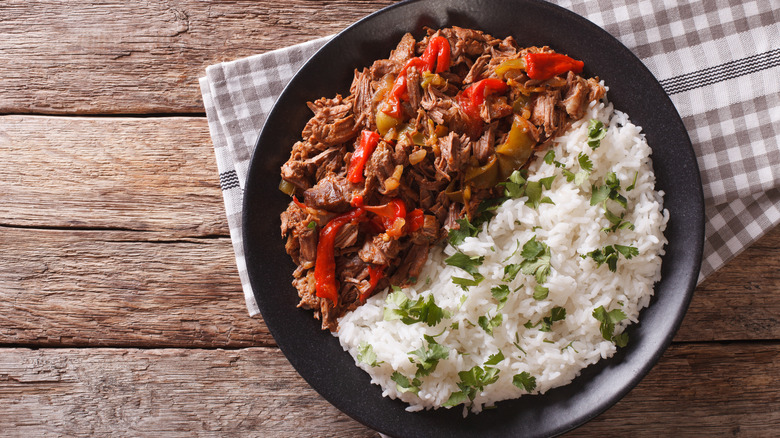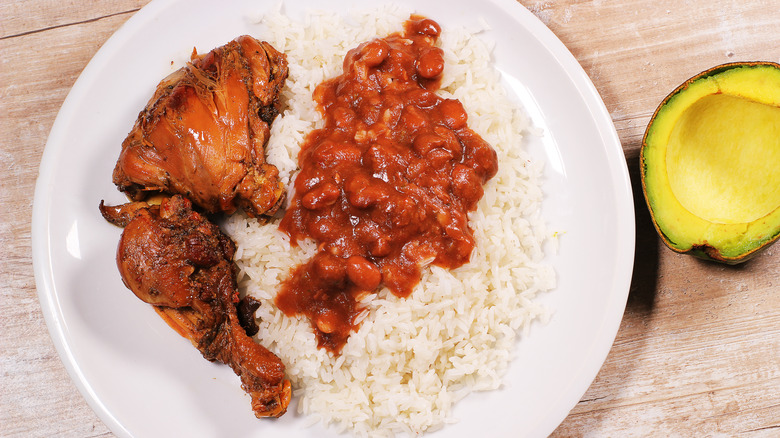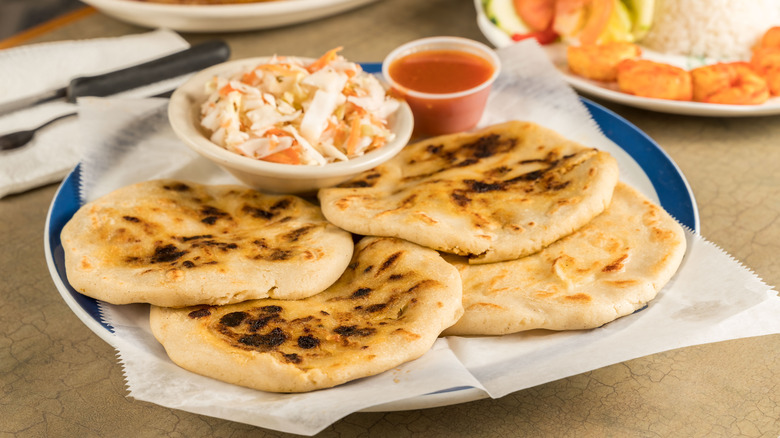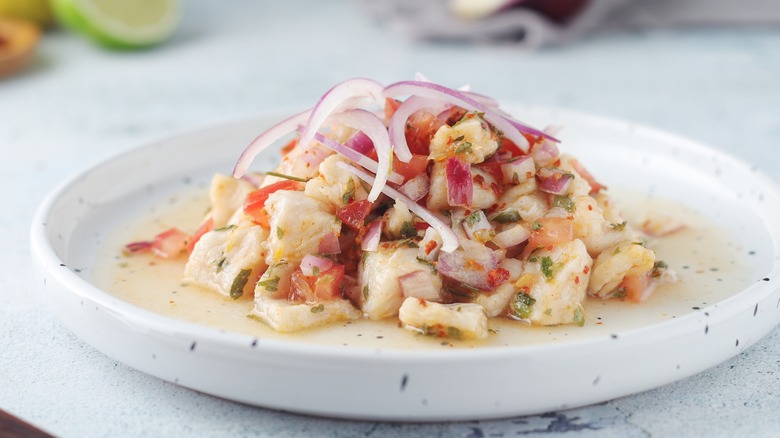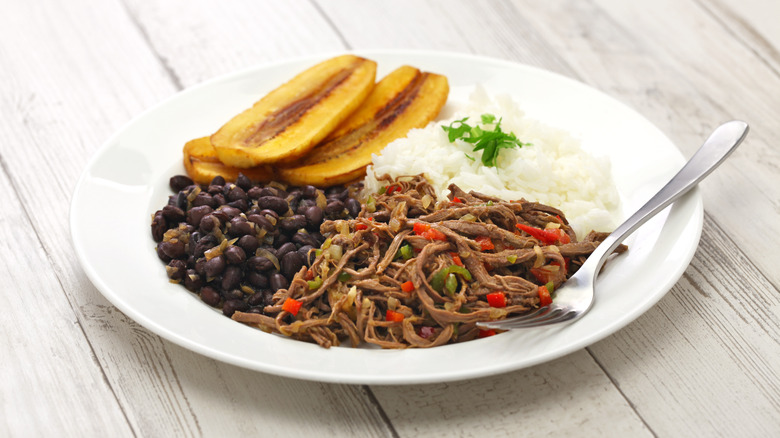The Must-Try National Dishes Of 5 Latin American Countries
Latin America is home to some of the best cuisines on Earth. From the warm beaches of the Caribbean to the chilly peaks of the Andes, each region brings its own natural bounties, and each nation its own unique dishes. The concept of picking national dishes is a bit of a controversial one, however. After all, how can you pick just one singular plate to represent an entire nation's culinary identity and history? It's asking quite a lot. Complicating matters is the fact that there isn't any official body that decides national dishes for the world.
Sometimes governments or ad agencies will promote a specific dish as the national specialty in an effort to drum up tourism, but more often than not, these tastes emerge as a consensus among the people over time. The truest test of a national dish is whether locals eat it on a regular basis, and how it ties into the region's culture and history at large. With that in mind, here are five dishes that are widely considered to be the national dishes of their respective countries, and the perfect starting point if you're ready to eat your way through Latin America.
Ropa vieja channels Cuba's colonial history
Ropa vieja is a stew of shredded beef with tomatoes, bell peppers, and onions. It is traditionally made with flank steak, which is one of the leanest cuts of beef, and the low-and-slow cooking process tenderizes the meat. When the beef gets shredded, it soaks up some of the sauce, making the meat moist and flavorful. The stew is traditionally served with sides of congri (white rice and black beans) and tostones (fried plantains).
Ropa vieja is a remnant of Cuba's colonial past, having originated in Spain. It is thought to have been invented by Sephardic Jews around the Iberian Peninsula in the 1100s. Forbidden from cooking on the Sabbath, they would prepare the ingredients for ropa vieja the night before, then let it cook, unattended, until it was time to eat. The name of the dish translates to English as "old clothes," due to the fact that the shredded beef looks like the stringy threads of worn-out clothing. There is also an old legend attached to the dish. It says that there was a poor man who had nothing to feed his family, so in desperation, he tore up his own clothing and put it in a pot. As it cooked, he prayed for a miracle, and before his eyes, the old rags turned into a delicious meat stew.
La Bandera, the Dominican Republic's patriotic and colorful meal
"La bandera" translates to "the flag," and this dish gets its name from the fact that each element represents one of the colors on the Dominican flag — red, white, and blue. The white is represented by rice, the red is represented by red beans, and the blue is represented by stewed meat. The exact type of meat varies, with pollo guisado (stewed chicken) being the most common choice. However, beef, pork, goat, or even fish may sometimes be used instead. The red beans are typically stewed with broth, tomatoes, and herbs.
La bandera is an everyday lunch for many Dominicans. It's a hearty dish made with pantry staples. It is usually served with savory double-fried plantains and a side salad. The most common choice of side salad is ensalada verde (mixed greens with vinaigrette), although ensalada Rusa (potato salad) and ensalada de coditos (macaroni salad) are also popular choices. You may also see sliced avocado served with la bandera. It is a highly flexible meal, adaptable to suit whatever ingredients are available and preferred.
Pupusas, the foundational flatbreads of El Salvador
Pupusas are so central to El Savador's culinary identity that the country has dedicated a holiday to them. They are certainly El Salvador's most famous culinary export, but for the uninitiated, a pupusa is essentially a type of stuffed flatbread. It is made from masa, the same kind of cornmeal dough that is also used to make Mexican corn tortillas. For pupusas, the dough is formed into a pocket and stuffed with a variety of fillings before being sealed shut and cooked on a flat-top griddle. The most popular fillings are beans, cheese, and chicharron (fried pork). Another classic filling is loroco, an earthy edible flower from Central America.
Pupusas have their roots in pre-Columbian times, evolving over centuries to incorporate new ingredients introduced from Europe, such as pork. Today, they are a staple food in El Salvador, found all over the country at pupuserias and roadside stands. Although typically eaten for lunch or dinner, they are sometimes enjoyed as a weekend breakfast. Pupusas are traditionally served with curtido, a slaw made of finely shredded cabbage and carrots fermented in vinegar.
Ceviche, a marvel of maceration from Peru
Ceviche is composed of diced raw seafood marinated in citrus juice. The acid in the juice triggers a chemical reaction called denaturing, which breaks some of the bonds between proteins in the seafood. This makes the fish firm and opaque, just like cooking over heat does, but unlike cooking over heat, it does not alter the flavor of the fish at all, preserving its freshness. The classic Peruvian ceviche is made with white ocean fish, such as sea bass, marinated in lime juice with sliced onions and chile peppers. Sometimes, bitter orange juice is used in place of lime.
There are multiple varieties of ceviche found throughout Latin America, but it is most closely associated with Peru, where it is the national dish. Ceviche has been a part of the local cuisine for so long that historians aren't even sure when it was invented, but the prevailing theory is that ceviche originated around 3,000 years ago in fishing villages along Peru's coastline. It was probably invented by the Moche people, and originally, the ingredients were a bit different. Citrus fruits wouldn't be introduced to South America until the Spanish began colonizing the region, so the fish was possibly marinated with some combination of acidic chile peppers, seaweed, and tumbo, a fruit related to passion fruit. You can still find versions like these in some of the cevicherias along Peru's beaches.
Pabellón criollo represents Venezuela's delicious confluence of cultures
Pabellón criollo is a hearty dish consisting of slices of beef cooked with tomatoes and served alongside rice and beans. The beef is typically flank steak, although occasionally, another lean cut, such as trimmed brisket, might be used instead. Once the beef is cooked, it is shredded before serving, similar to Cuba's ropa vieja. This dish also has a symbolic meaning in Venezuelan culture. The colors of the white rice, black beans, and brown meat that make up pabellón criollo are said to symbolize the combination of indigenous American, colonial European, and enslaved African peoples whose histories shaped present-day Venezuela.
Pabellón criollo can be served with a variety of accompaniments, a particularly common choice being tajadas, or fried sweet plantains. If you order pabellón criollo with tajadas, it is said to be served "con barandas," meaning "with side rails," referring to the curved shapes of the plantain slices, which appear like guardrails on the edges of the plate. You could also order your pabellón criollo "a caballo," which means you'll get a fried egg on top.
